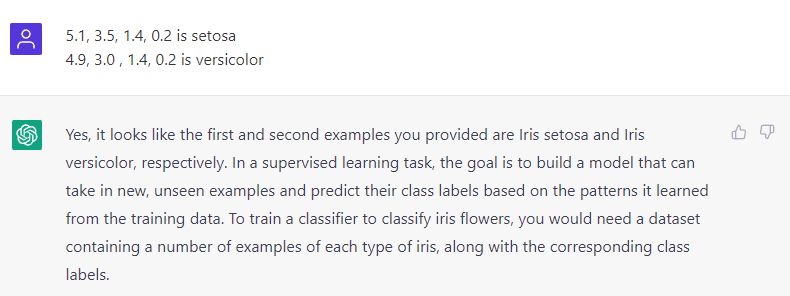ChatGPT can solve simple machine learning tasks as classification and categorization

In Brief
ChatGPT can help you with simple machine learning tasks – here’s how
ChatGPT is a chatbot that can help you with simple machine-learning tasks, such as classification and categorization. It uses a natural language processing algorithm to understand your questions and provide accurate answers. You can train ChatGPT to be more accurate by providing it with more data. The tool is designed to be easy to use and requires minimal training.
Using ChatGPT for simple machine-learning tasks can be a great way to get accurate results without having to put in a lot of effort. The chatbot is able to understand your questions and provide accurate answers thanks to its natural language processing algorithm. You can further improve the chatbot’s accuracy by providing it with more data. ChatGPT is easy to use and requires minimal training, making it a great option for those who want to get started with machine learning tasks.

ChatGPT wasn’t created with the goal of making machine learning more accessible to everyone. That said, ChatGPT has a few advantages that make it worth checking out for your machine learning needs. First, ChatGPT is designed to be easy to use. It has a simple, intuitive interface that makes it easy to get started. Second, ChatGPT is fast. It can quickly handle large amounts of data, making it ideal for tasks that require a lot of processing power. It consistently produces high-quality results, which is essential for any machine learning task.
How ChatGPT can help with machine learning tasks
ChatGPT is a platform that allows you to launch virtual ML algorithms that can engage in natural conversations. In order to create your ML, you need to provide ChatGPT with data. This data can be in the form of labels, numbers, or any other data that you have that can be used to train the chatbot.
Once you have provided the data, ChatGPT will then use this data to train the chatbot. The training process can take a few seconds, depending on the amount of data that you have provided. Once the training is complete, you will have a chatbot that is ready to engage in natural conversations. Take a look at the examples below.

It is best to supply data as simple text that is separated by commas because ChatGPT does not understand arrays.

Once the bot has been trained, you can get results by making inquiries.

Another ML assignment with numeric inputs and city labels is shown below. In that instance, ChatGPT will attempt to forecast the city based on monthly income and stress levels.

Finally, ChatGPT is capable of handling elementary machine-learning tasks like classification and categorization. ChatGPT can also be used to forecast the value depending on input data, as seen in the aforementioned example.
Read more about ChatGPT:
Disclaimer
In line with the Trust Project guidelines, please note that the information provided on this page is not intended to be and should not be interpreted as legal, tax, investment, financial, or any other form of advice. It is important to only invest what you can afford to lose and to seek independent financial advice if you have any doubts. For further information, we suggest referring to the terms and conditions as well as the help and support pages provided by the issuer or advertiser. MetaversePost is committed to accurate, unbiased reporting, but market conditions are subject to change without notice.
About The Author
Damir is the team leader, product manager, and editor at Metaverse Post, covering topics such as AI/ML, AGI, LLMs, Metaverse, and Web3-related fields. His articles attract a massive audience of over a million users every month. He appears to be an expert with 10 years of experience in SEO and digital marketing. Damir has been mentioned in Mashable, Wired, Cointelegraph, The New Yorker, Inside.com, Entrepreneur, BeInCrypto, and other publications. He travels between the UAE, Turkey, Russia, and the CIS as a digital nomad. Damir earned a bachelor's degree in physics, which he believes has given him the critical thinking skills needed to be successful in the ever-changing landscape of the internet.
More articles

Damir is the team leader, product manager, and editor at Metaverse Post, covering topics such as AI/ML, AGI, LLMs, Metaverse, and Web3-related fields. His articles attract a massive audience of over a million users every month. He appears to be an expert with 10 years of experience in SEO and digital marketing. Damir has been mentioned in Mashable, Wired, Cointelegraph, The New Yorker, Inside.com, Entrepreneur, BeInCrypto, and other publications. He travels between the UAE, Turkey, Russia, and the CIS as a digital nomad. Damir earned a bachelor's degree in physics, which he believes has given him the critical thinking skills needed to be successful in the ever-changing landscape of the internet.






















































